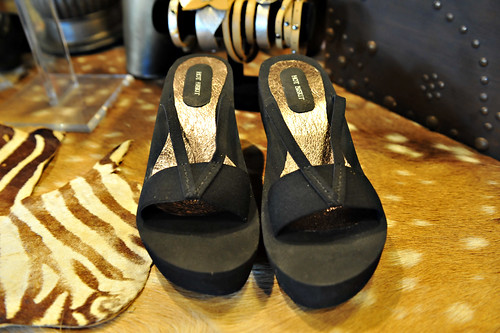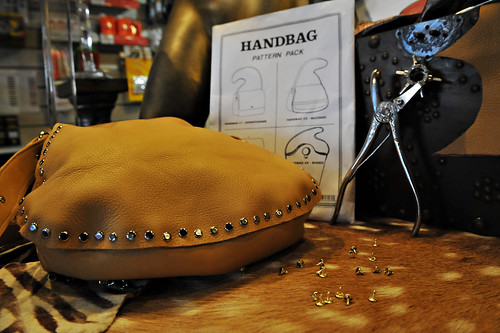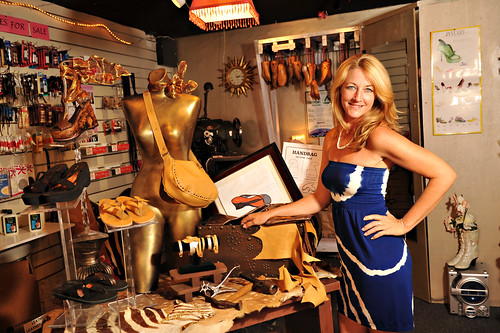
Teri Edmonds, Maui Shoe Academy and If The Shoe Fits, all photos Courtesy of Sean Hower http://howerphotos.com
Standing next to a giant belt sander that’s putting the finishing touches on the soles, I’m really impressed that I just constructed my own pair of shoes. I’m finishing up a class at Maui Shoe Academy in Wailuku and will soon go home with an amazing work of completely wearable art.
Most people take the shoes on their feet for granted, but not Teri Edmonds, the proprietor behind If the Shoe Fits and Maui Shoe Academy. Her ambition is to create a self-sustaining Maui shoe brand as well as rally behind anyone who wants to make shoes and work with leather.

Hot Biskit Wedge
Edmonds has owned If the Shoe Fits for a while, but purchased the shoe manufacturing machines from Tester’s Shoe Repair when they decided to close a few years back and added them to her ever-evolving repertoire at the store. Then she started to learn how to make a shoe from scratch. At her store you will find her own line of custom-made shoes under the Hot Biskit brand, along with a line of custom, dyeable prom shoes, shoe improvement supplies and shoe and leather repair. Edmonds runs the shoe courses right in her store, which features much of her industrial shoe-making equipment.
“I’m driven primarily to create a business/industry that is self-sustaining,” said Edmonds. “When the earthquake occurred a few years back, I knew I would need to get creative with my use of materials: using local leathers, getting creative on non-traditional binding materials, etc. I’m looking for ways to keep my business local. I’m also driven by the fact that I need to make from scratch what the shoe industry is unwilling to furnish–wide and large sizes, small sizes and custom footwear for people that can’t find shoes anywhere else. If you’re a young girl with a size 15 foot, you’re going to need a custom prom shoe, and that’s what I can now provide.”

Make a Sandal Course
Two years ago, Edmunds held a shoe design contest and art show at Cafe Marc Aurel (now Wailuku Coffee Company) in hopes of inspiring a sustainable shoe culture on Maui. Entries had to feature products that designers could obtain on the island and there was no limit to the creativity they could draw on to embellish their shoes. Now she’s focused her attention on teaching shoe and leather arts.
“I really want to see more women empowered with the skills necessary to create their own shoe design businesses,” Edmonds said. “There are many aspiring young designers. My intern, Lisa Kori Chung, is a perfect example of the type of clients I hope to inspire by my school. She is an aspiring artist and designer and is interested in exploring the art of shoemaking.”

The Maui Shoe Academy was born with three courses: “Make a Sandal in a Day,” “Leather Handbag” and “Make a Moccasin.” For this story, I took the sandal and handbag courses. Edmonds began with a quick lesson in the history of cobbling.
Shoe makers in Britain before the Industrial Revolution were highly regarded in society. It was a time when people appreciated the difficult hand labor that went into making shoes that were both fashionable and protected and warmed their feet.
By the late 1800s, a “pop up” shoe business was available for entrepreneurs in the U.S. People would purchase the whole set-up as a package, which came with all the necessary shoe-making equipment the shop needed, minus the labor, of course.
“These early retail shoe stores in the U.S. were called the 10-foot shoe store,” Edmonds said. “The business model was a 10-foot building and unassembled products sent to a community farmer, typically. The farmer would assemble the shoe according to the customers’ needs. This is similar to my Hot Biskit ‘Just for You Shoe.’ The JFYS is assembled to our customers’ specifications.”
Which is how I got to make my own shoes and a handbag. The later of which required me to punch out more than 120 pukas into pieces of soft leather that I cut out according to a pattern. Later, I hammered rivets into each hole to bring the two pieces of leather together. As the handbag came to life I felt an amazing satisfaction to have made my own bag, rather than buying a faux leather import from China for $30 at the mall.

Teri’s long term goal is to foster a burgeoning community of DIY designers, shoemakers, leather tanners and material weavers who create what they can from materials they find on Maui. Although her courses may seem expensive (they run$250 to $400), she compares them to another independent shoe making school in Arizona where courses cost more than double that.
What’s more, her sandal-making course is now expanding to Vitec, where it will be offered for the first time on June 5 (details on that can be found in the upcoming “EdVenture Maui College Summer Catalog”). Other scheduled courses for leather sandal and handbag making are posted on the mauishoeacademy.com website. Both courses are one-day events. Sandal-making classes take place on Mar. 17, Apr. 21 and May 19; handbag course happen on Mar. 31, Apr. 28 and May 26. This summer she also plans to add shoe decorating and leather accessories classes.
“I want Maui to be a shoe manufacturing destination,” Edmonds said. “Whether it be by designers creating small batches or designers with more grand aspirations.”